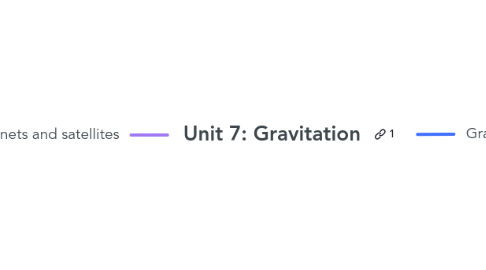
1. Orbits of planets and satellites
1.1. The centripetal force acting on a satellite is provided by the force of gravity between the satellite and a planet
1.1.1. Fg = Fc
1.1.2. Therefore the circular orbital velocity of a satellite is inversely proportional to the square root of the radius and does not depend on mass
1.2. Launching a satellite into orbit
1.2.1. It is possible to calculate the energies of a satellite being launched into space through using the equation E = K +U, and you can consider total energy is potential when on the surface
1.2.1.1. To calculate work needed to pull a satellite into orbit, you can use the equation W = Etotal - U
1.2.1.1.1. To calculate the speed of this satellite, use V = sqrt(GM/r) (all of these calculations came from NMSI questions page 10).
1.3. Circular velocity of Satellite caused by centripetal forces
1.3.1. V = V0=rGM
1.3.1.1. Velocity also equals 2piR/T
1.4. Kepler's 1st law
1.4.1. Law of Orbit's
1.4.1.1. Kepler's First Law: each planet's orbit about the Sun is an ellipse. The Sun's center is always located at one focus of the orbital ellipse. The Sun is at one focus. The planet follows the ellipse in its orbit, meaning that the planet to Sun distance is constantly changing as the planet goes around its orbit.
1.5. Keplers 2nd law
1.5.1. Law of Areas
1.5.1.1. A line joining a planet to the sun causes the derivative of the area between them to become constant
1.5.1.1.1. This means that the vector combining them sweeps out any amount of area in equal time due to the orbit and its speed
1.6. Using netwons second law, an equation can be derived to show the satellites period of dependence on orbital distance
1.6.1. Kepler's third law of periods
1.6.1.1. T^2 = (4pi^2/GM)r^3
1.6.1.1.1. T^2 = r^3
1.6.1.1.2. This relationship can be linearized through making T^2 the y axis and r^3 the x axis of said graph
1.7. Frequency
1.7.1. f = 1/T
1.8. Period
1.8.1. T = 1/f
1.9. Centripetal force
1.9.1. Fc = MV^2/r
1.9.1.1. Centripetal acceleration ac
1.9.1.1.1. ac = v^2/r
1.10. The gravitational potential energy of a satellite-planet system is characterized by the potential energy function of the system
1.10.1. Ug = -GMeMsat/r
1.10.1.1. Change in U = mgh
1.10.2. Kinetic energy = 1/2MV^2
1.10.3. Angular momentum and total mechanical energy do not change for a satellite in orbit
1.10.3.1. Therefore we can make Kinetic energy = potential energy
1.10.3.1.1. This gives us a function for total mechanical energy of the satellite
1.10.3.2. Total mechanical energy is always negative, 1/2 of the total potential energy and is inversely proportional to the orbital distance r
1.10.3.3. At an infinite distance away from a planet, a satellite is known to have a zero value for gravitational potential energy
1.10.3.4. Mechanical energy stays the same because the work being done upon the system is internal
1.10.3.5. The function for kinetic energy of a satellite can be reduced to the point where only position and the system is needed
1.11. Escape velocity or speed is defined as the minimum speed or velocity needed to escape the gravitational field of a planet
1.11.1. The escape velocity can be calculated through the formula Ve = sqrt(2GM/r)
1.11.2. At some large distance away from the gravitational field, this can be achieved when the satellite reaches some nominal speed of exactly 0.
1.12. angular velocity
1.12.1. 2pi/T
1.12.1.1. V * r
1.13. Angular velocity is constant and Angular momentum is conserved in a satellite satellite system
1.13.1. This means that even in collision between to satellites, momentum is conserved
1.13.1.1. IW1 + IW2 = IW1 + IW2 (I = inertia, w = Angular velocity)
1.13.1.1.1. Using these three equations, you can calculate the distances and velocities of a satellite being shot up into the air. (See link attached to Laufer's notes for more)
1.13.1.2. I = MR^2
1.13.1.3. W = V * r
1.13.2. Angular momentum = IW = MVR
1.14. Using dm = pdV
1.14.1. and P = Me/Ve
1.14.1.1. with the gemoetry of a ring or any object being affected by a gravitational field in said two body question
1.14.1.1.1. you can use variable calculus and integrations to calculate the value of dm, for example on a certain part of a ring.
1.15. Aphelion
1.15.1. The position in which a planet is furtherst away from the sun in its orbit
1.15.1.1. The formula to calculate the speed of a satellite at Aphelion
1.15.1.1.1. (2piA)/Tperiod) * sqrt(1-e/1+e)
1.16. Perihelion
1.16.1. The position in which a planet is closest to the sun in its orbit
1.16.1.1. The formula to calculate the speed of a satellite at Perihelion
1.16.1.1.1. (2piA)/Tperiod) * sqrt(1+e/1-e)
2. Gravitational Forces
2.1. Calculating the gravitational force between two spherically large objects
2.1.1. |Fg| = Gm1m2/r^2
2.1.1.1. Thus objects with larger masses will create larger gravitational fields, which would have stronger interactions at a distance with other objects that also have mass
2.1.1.1.1. The larger the mass between both objects, the stronger the gravitational interaction
2.2. value g = gravitational acceleration of an object close to earths surface or another large planet
2.2.1. g = GMe/Re^2
2.2.2. If far from earths surface, where r = distance from earth
2.2.2.1. g = GMe/r^2
2.2.3. r = Re + h
2.3. Gravitational force is inversely proportional to distance squared, meaning any acceleration under the influence of said force must be non-uniform
2.3.1. Fg = 1/r^2
